
Cyprinus is the genus of typical carps in family Cyprinidae. Most species in the genus are of East Asia origin with only the common carp in Western Asia and Europe; this invasive species has also been introduced to many other regions around the world. Cyprinus are closely related to some more barb-like genera, such as Cyclocheilichthys and Barbonymus (tinfoils). The crucian carps (Carassius) of western Eurasia, which include the goldfish, are apparently not as closely related.
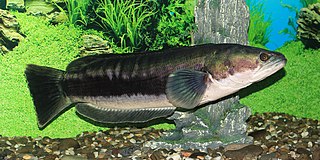
Channa is a genus of predatory fish in the family Channidae, commonly known as snakeheads, native to freshwater habitats in Asia. This genus contains about 50 scientifically described species. The genus has a wide natural distribution extending from Iraq in the west, to Indonesia and China in the east, and parts of Siberia in the Far East. A particularly high richness of species exists in Myanmar (Burma) and northeastern India, and many Channa species live nowhere else. In contrast, a few widespread species have been introduced to several regions outside their natural range, where they often become invasive. The large and medium-sized Channa species are among the most common staple food fish in several Asian countries, and they are extensively cultured. Apart from their importance as a food fish, snakeheads are consumed in some regions as a traditional medicine for wound healing and reducing postoperative pain and discomfort, and collected for the international aquarium pet trade.

Danio is a genus of small freshwater fish in the family Cyprinidae found in South and Southeast Asia, commonly kept in aquaria. They are generally characterised by a pattern of horizontal stripes, rows of spots or vertical bars. Some species have two pairs of long barbels. Species of this genus consume various small aquatic insects, crustaceans and worms.
Mastacembelus is a genus of many species of spiny eel fish from the family Mastacembelidae. They are native to Africa and Asia. Most are found in rivers and associated systems, but there are also species in other freshwater habitats and a particularly rich radiation is found in the Lake Tanganyika basin with 15 species. A few species can even occur in brackish water.
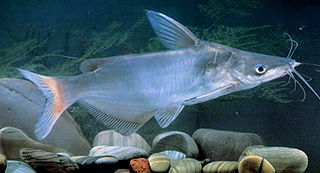
Cranoglanis is the only genus of armorhead catfishes.

Hemiculter is a genus of cyprinid fish, consisting of eight species native to fresh water of eastern Asia. The type species is the sharpbelly, Culter leucisculus. The name is derived from the Greek word hemis, meaning "half", and the Latin word culter, meaning "knife".

Acheilognathus is a genus of cyprinid fish native to Asia. The name is derived from the Greek a, meaning "without", the Greek cheilos, meaning "lip", and the Greek gnathos, meaning "jaw".

Hemibagrus is a genus of catfishes of the family Bagridae.
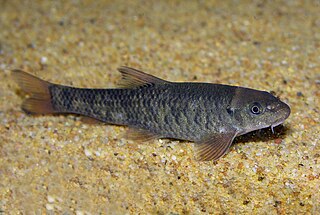
Garra is a genus of fish in the family Cyprinidae. These fish are one example of the "log suckers", sucker-mouthed barbs and other cyprinids commonly kept in aquaria to keep down algae. The doctor fish of Anatolia and the Middle East belongs in this genus. The majority of the more than 160 species of garras are native to Asia, but about one-fifth of the species are from Africa.

Schistura is a genus of fish in the stone loach family Nemacheilidae native to the streams and rivers of the southern and eastern Asia. Some of these species are troglobitic.
Sinogastromyzon is a genus of hillstream loaches native to eastern Asia.

Monopterus is a genus of swamp eels native to Asia. They live in various freshwater habitats and some have a fossorial lifestyle.
Placocheilus caudofasciatus is a species of cyprinid native to Laos, Vietnam and China in eastern Asia. This species can reach a length of 10.9 centimetres (4.3 in) SL.

Beaufortia is a genus of gastromyzontid loaches from China and mainland Southeast Asia.
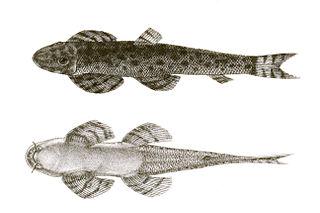
Balitora is a genus of ray-finned fishes in the family Balitoridae endemic to Asia.
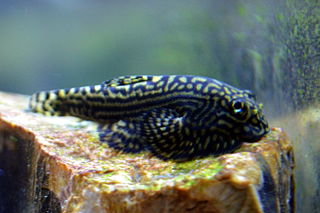
Sewellia is a genus of fish in the family Gastromyzontidae. They are commonly called hillstream loaches and are found in Laos and Vietnam. According to Roberts (1998) a possible defining characteristic of the genus Sewellia is their posterior pelvic valve is highly complex and different from other rheophilic loaches, their posterior pelvic valve involves the overlapping of the second to last ventrally exposed rays. Adapted to high velocity streams, Sewellia have depressed body shapes that are laterally expanded, thus increasing their hydrodynamical properties and allowing them to better stay attached to rocks in swift current. Sewellia also have paired fins with a single simple ray and numerous branched rays allowing them to grip rocks in swift current.

Opsariichthys is a genus of cyprinid fish found in freshwater habitats in Mainland China, Taiwan, Japan, Korea, and Vietnam. There are currently 12 described species in the genus.
Sinilabeo is a genus of cyprinid freshwater fish found in China and Vietnam.

Macropodus is a genus of small to medium-sized labyrinth fish native to freshwater habitats in eastern Asia. Most species are restricted to southern China and Vietnam, but M. opercularis occurs as far north as the Yangtze basin, and M. ocellatus occurs north to the Amur River, as well as in Japan and Korea. In China, they are often used for fights, so they are named Chinese bettas because of their similarity to the genus Betta. A few species in the genus are regularly seen in the aquarium trade, and M. opercularis has been introduced to regions far outside its native range.
Vinagarra is a genus of ray-finned fish in the family Cyprinidae endemic to Vietnam.














